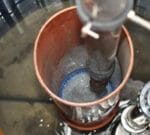Hydrosystem
Hydrosystem 1000
A highly efficient modular filter with unique features for installation in a well or similar enclosed surface. Depending on the filtration medium chosen, rainwater from conventional roofs, metal roofs, traffic areas, including heavily trafficked surfaces up to 1000 m² can be treated.
The filter is extremely efficient and the treated water can be diverted directly back into streams and waterways, but can also be connected to collection systems and tanks to recycle everything. It flows into the municipal system or directly into groundwater.
The system was created to meet the new obligation of water authorities to ensure the implementation of the EU Water Framework Directive.
The specially designed filter materials are easy to replace using the built-in handle and should last up to 1 year under normal load between required maintenance intervals. We offer 2 different filter materials depending on the application, metal and high flow rate.
Description
Installed in a concrete well (plastic also available).
"Heavy traffic" (rainwater) for surfaces up to 1000 m2.
"Metal" (metals only) for surfaces up to 1000 m2.
"Roof" (ceiling) for surfaces up to 1000 m2. Note: In case of high loads, surfaces may be limited, please contact us.
Maximum flow, hydraulic, 12 l/s.
Minimum flow, hydraulic, 2,5 l/s.
Note! The above is based on regular maintenance and cleaning.

Dimensioning
Hydrofilter dimensions:
To choose the right filter solution, please refer to the following points
1. Which ISSUE is applicable where there is an accumulation of rainwater to be removed and a potential traffic volume?
2. What are the applicable flows and potential rainfall intensities?
3. Priority substances to filter/absorb?
4. Installation possibilities/restrictions?
The measurements in the table below show the additional performance of the filter and the test results. In addition, the filter is a DiBt approved German standard.

Maintenance
Functional principle
Functional principle
- The water to be filtered/purified is piped to the filter (bottom).
- After passing through the inlet, the water enters a hydrodynamic separator, which creates a strong radial flow. This means that particles start to settle, which is particularly the case for heavier particles such as sand, which then fall to the bottom of the filter.
- At the bottom of the filter there is a special collection container for silt/sand/dirt, which is accessible via a "By pass" inside the filter housing. (Emptying is done by vacuuming the empty container).
- The filter media is placed in the middle of the filter housing, and as the water moves upwards, it must be passed through and then absorb unwanted fine particles during the various stages of degradation. The filters now bind the particles/impurities and what passes through is the purified water. The top of the filter has a drain hole for easy cleaning if the filter material is prone to clogging due to heavy temporary soiling/contamination.
- Once the water has passed through the filtration medium, on its way up through the filter housing, the next purification step takes place, i.e. oil and similar liquids can also be separated through the oil separator, and the purified water ends up in the surface layer and is discharged out through the outlet.












